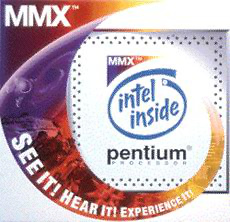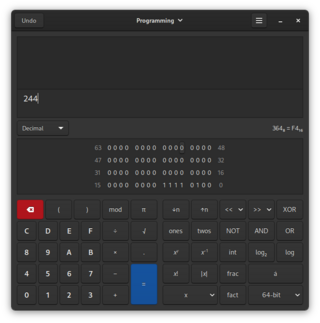
Alpha is a 64-bit reduced instruction set computer (RISC) instruction set architecture (ISA) developed by Digital Equipment Corporation (DEC). Alpha was designed to replace 32-bit VAX complex instruction set computers (CISC) and to be a highly competitive RISC processor for Unix workstations and similar markets.
IA-32 is the 32-bit version of the x86 instruction set architecture, designed by Intel and first implemented in the 80386 microprocessor in 1985. IA-32 is the first incarnation of x86 that supports 32-bit computing; as a result, the "IA-32" term may be used as a metonym to refer to all x86 versions that support 32-bit computing.

x86 is a family of complex instruction set computer (CISC) instruction set architectures initially developed by Intel based on the Intel 8086 microprocessor and its 8088 variant. The 8086 was introduced in 1978 as a fully 16-bit extension of Intel's 8-bit 8080 microprocessor, with memory segmentation as a solution for addressing more memory than can be covered by a plain 16-bit address. The term "x86" came into being because the names of several successors to Intel's 8086 processor end in "86", including the 80186, 80286, 80386 and 80486 processors. Colloquially, their names were "186", "286", "386" and "486".

SPARC is a reduced instruction set computer (RISC) instruction set architecture originally developed by Sun Microsystems. Its design was strongly influenced by the experimental Berkeley RISC system developed in the early 1980s. First developed in 1986 and released in 1987, SPARC was one of the most successful early commercial RISC systems, and its success led to the introduction of similar RISC designs from many vendors through the 1980s and 1990s.

MMX is a single instruction, multiple data (SIMD) instruction set architecture designed by Intel, introduced on January 8, 1997 with its Pentium P5 (microarchitecture) based line of microprocessors, named "Pentium with MMX Technology". It developed out of a similar unit introduced on the Intel i860, and earlier the Intel i750 video pixel processor. MMX is a processor supplementary capability that is supported on IA-32 processors by Intel and other vendors as of 1997.
In computing, Streaming SIMD Extensions (SSE) is a single instruction, multiple data (SIMD) instruction set extension to the x86 architecture, designed by Intel and introduced in 1999 in their Pentium III series of central processing units (CPUs) shortly after the appearance of Advanced Micro Devices (AMD's) 3DNow!. SSE contains 70 new instructions, most of which work on single precision floating-point data. SIMD instructions can greatly increase performance when exactly the same operations are to be performed on multiple data objects. Typical applications are digital signal processing and graphics processing.
The Intel i860 is a RISC microprocessor design introduced by Intel in 1989. It is one of Intel's first attempts at an entirely new, high-end instruction set architecture since the failed Intel iAPX 432 from the beginning of the 1980s. It was the world's first million-transistor chip. It was released with considerable fanfare, slightly obscuring the earlier Intel i960, which was successful in some niches of embedded systems. The i860 never achieved commercial success and the project was terminated in the mid-1990s.
In computer architecture, 64-bit integers, memory addresses, or other data units are those that are 64 bits wide. Also, 64-bit central processing units (CPU) and arithmetic logic units (ALU) are those that are based on processor registers, address buses, or data buses of that size. A computer that uses such a processor is a 64-bit computer.

x86-64 is a 64-bit version of the x86 instruction set, first released in 1999. It introduced two new modes of operation, 64-bit mode and compatibility mode, along with a new 4-level paging mode.
SSE2 is one of the Intel SIMD processor supplementary instruction sets introduced by Intel with the initial version of the Pentium 4 in 2000. It extends the earlier SSE instruction set, and is intended to fully replace MMX. Intel extended SSE2 to create SSE3 in 2004. SSE2 added 144 new instructions to SSE, which has 70 instructions. Competing chip-maker AMD added support for SSE2 with the introduction of their Opteron and Athlon 64 ranges of AMD64 64-bit CPUs in 2003.

GNU Multiple Precision Arithmetic Library (GMP) is a free library for arbitrary-precision arithmetic, operating on signed integers, rational numbers, and floating-point numbers. There are no practical limits to the precision except the ones implied by the available memory (operands may be of up to 232−1 bits on 32-bit machines and 237 bits on 64-bit machines). GMP has a rich set of functions, and the functions have a regular interface. The basic interface is for C, but wrappers exist for other languages, including Ada, C++, C#, Julia, .NET, OCaml, Perl, PHP, Python, R, Ruby, and Rust. Prior to 2008, Kaffe, a Java virtual machine, used GMP to support Java built-in arbitrary precision arithmetic. Shortly after, GMP support was added to GNU Classpath.

The GNU Multiple Precision Floating-Point Reliable Library is a GNU portable C library for arbitrary-precision binary floating-point computation with correct rounding, based on GNU Multi-Precision Library.
In computer security, executable-space protection marks memory regions as non-executable, such that an attempt to execute machine code in these regions will cause an exception. It makes use of hardware features such as the NX bit, or in some cases software emulation of those features. However, technologies that emulate or supply an NX bit will usually impose a measurable overhead while using a hardware-supplied NX bit imposes no measurable overhead.
In C and related programming languages, long double refers to a floating-point data type that is often more precise than double precision though the language standard only requires it to be at least as precise as double. As with C's other floating-point types, it may not necessarily map to an IEEE format.
The Time Stamp Counter (TSC) is a 64-bit register present on all x86 processors since the Pentium. It counts the number of CPU cycles since its reset. The instruction RDTSC returns the TSC in EDX:EAX. In x86-64 mode, RDTSC also clears the upper 32 bits of RAX and RDX. Its opcode is 0F 31. Pentium competitors such as the Cyrix 6x86 did not always have a TSC and may consider RDTSC an illegal instruction. Cyrix included a Time Stamp Counter in their MII.
Extended precision refers to floating-point number formats that provide greater precision than the basic floating-point formats. Extended precision formats support a basic format by minimizing roundoff and overflow errors in intermediate values of expressions on the base format. In contrast to extended precision, arbitrary-precision arithmetic refers to implementations of much larger numeric types using special software.
Advanced Vector Extensions (AVX) are extensions to the x86 instruction set architecture for microprocessors from Intel and Advanced Micro Devices (AMD). They were proposed by Intel in March 2008 and first supported by Intel with the Sandy Bridge processor shipping in Q1 2011 and later by AMD with the Bulldozer processor shipping in Q3 2011. AVX provides new features, new instructions, and a new coding scheme.
In computing, quadruple precision is a binary floating point–based computer number format that occupies 16 bytes with precision at least twice the 53-bit double precision.







